Wearing old clothes: Part 1
In which I attempt to do something I have been wanting to try for a long, long time
I must preface this newsletter by stating that it is currently in the high 30s here in central France, that this is the third week of such temperatures, and that my brain melted on Sunday and ran out my ears when I misguidedly tried to go swimming at our local river swimming hole and found the ambient air temperature so high that I started malfunctioning, like a slightly older model of electronic good.
And that I almost fainted photographing this newsletter, especially the army paletot. I was going to include a pair of thick corduroy johdpurs in this round, but it was a bridge too far.
So, disclaimers out of the way, I have been thinking for a very long time of doing a series like the one I am starting today. I finally decided to do it after seeing an instagram clip about how the best clothing designers are also clothing collectors, especially vintage and antique. Something I have mentioned in passing a couple of times now is that I got my start in this business very early in life. I partially grew up in a hippie commune in the country in the 80’s and 90’s, and I was constantly dressed in other people’s clothing from op-shops (or scrounged from one of my father’s many girlfriends or the people who would randomly move into our house - I wasn’t above appropriating things I thought would look better on me!). I started collecting vintage clothing when I was about 13 or 14, drawn by the beauty of the fabrics and embellishments and the cut. The early 90’s were also a fantastic time for vintage, as wearing it became suddenly extremely fashionable, and I was then in my late teens and early 20s, had yet to have kids, and everything fitted. And I collected. And collected. And have continued to collect.
I have now a ridiculous collection of silk lingerie, which was always my first and most favourite obsession, particularly pieces from the 1920’s, 30’s and early 40’s. In much of my early collecting I drew the line somewhere in the early 50’s, and still most post-50’s fashion doesn’t interest me so much. I realised, when analysing why, that it was both the shape and the fabrics used - the 50’s marked the last time that, for me at least, fashion really played around with shape and contrast (let’s skip the 80’s and those shoulderpads, please, let’s just try to forget…), and they also mark the decade where the use of synthetic textiles began to outweigh natural.
I don’t do synthetic. Never have, never will. Synthetic fabrics are ugly, end of.
Many of the pieces in my collection have now been with me for 30+ years, and I still think they are some of the most beautiful clothes I’ve come across. And I am finding new pieces all the time. My daughter, having for years been dismissive of all things second hand and a little bit rough at the edges, now regularly puts her spoke in for pieces she likes, and my son has joined the fray although he mostly wants my jewellery, which is also mostly thrifted or antique.
Anyway, for a long time I’ve wanted to try to show how I might wear some of the vintage pieces I come across, because I have never thought of second-hand clothes as second best - they are simply not, and I really want people to see how amazing the shapes and fabrics are and to get inspired to find and wear the real thing, not some insipid copy (although now and again I do see really wonderful new pieces based on the shapes of old pieces, although it is rare that the fabric quality matches that of the original pieces).
As a jumping-off point I looked at a couple of the pieces I had ready for sale, and thought - now how would I wear these? I ransacked my own collection to find things I thought worked with them, and the result is here.
I have modelled the clothes I find many times before now, and I’m not too worried about what they look like on me, a middle-aged perimenopausal woman who has birthed and breastfed two children. What I wish I could improve are my photography skills when it comes to people, and so I am working up the courage to ask friends to model for me when I next do this (this conversation will go “hey want to come wear my clothes and prance around whilst I pretend to know what I am doing so that one day in the future I will know what I am doing”, only in French). Until I get that courage, I have to just keep practising with myself, but it’s not so educational because I can’t see the light or aim the camera when I am taking my own photo - the camera has to sit on a tripod with the settings already in place whilst I skid round to the front and try to arrange myself before the timer shutter goes off.
All of this is to say - in short - I hope to get better at this. So anyway, here goes…
The items I have for sale are a late 19th century patterned cotton petticoat skirt, a very fine cotton early 20th century shirt with magnificent pintucks and cutwork flouncy sleeves and collar, and a rather wonderful never-worn army paletot, from probably the early to mid-50’s. These three pieces represent three magnificent shapes, because vintage and antique clothes, above all, have magnificent shapes, which modern clothing largely lacks.
I chose from my own wardobe three other pieces, a 1950’s pair of blue high-waisted workpants with a cinched belt at the back, a sleeveless 1930’s drawn-thread fine silk blouse with pearl buttons, and a 1960’s or 70’s navy canvas jacket which was originally white like a lot of navy clothing was/is, but which has been dyed with natural indigo to a deep blue. Again, all three have magnificent shapes.
I wanted to say a couple of things about the pieces that I own that are in this series of photos. The first is that all three of them are used and show it. The pants have a rough repair on the leg. The navy jacket has a little wear. The silk shirt has small marks and sweat stains under the arms, and at some point it has been expertly patched. In fact these patches are so beautiful I photographed them, because, as anyone who has been following me for a while now would know, I love repairs. Here they are:
This shirt also has another lovely and inspiring little detail - someone has made double-sided shank buttons for it, using fake pearl buttons on one side and little chunky mother-of-pearl buttons on the other. Here is a picture of those buttons:
And just look also at the thread-work on this, remembering that this is finest silk. Look below at the stitching of the seams:
This is why I love handmade antique clothing. Little details like this. And I will happily put up with and even cherish the imperfections, which are signs of a life lived and also of the hand and the energy of the person who first loved the garment. I feel that love and I sometimes add to it by continuing to repair pieces.
The other thing I’d like to point out is that the navy jacket was not only dyed in indigo, it was professionally adjusted at the shoulders - the arms were completely unpicked and reset more narrowly because this is obviously a men’s jacket, and the result is something that looks very sharp indeed. France has wonderful tailors and one of the secrets of why many French people look so put-together is that they will take even new clothing to their tailor and get them altered to fit precisely. I have had this done with men’s workshirts as well as this jacket, and I currently have a 1960’s men’s tweed overcoat and a very long and large work jacket being resized by my tailor, who is sadly shutting up shop at the end of July after four decades in the business.
If you really want your clothes to hang well, you sometimes do need to get them adjusted by a good tailor. It’s worth it. And a good quality piece of clothing that you have taken the time and money to adjust to fit you exactly will always repay and will always make you feel good.
Ok so onto the pictures. Firstly here is the petticoat with the sleeveless silk blouse:
This skirt has a double-layered flounce, which was deliberately done to make the overskirt stand out. Women often wore several petticoats depending on the occasion and the weather - for women who couldn’t afford hoops when they were fashionable, or for working women who couldn’t wear a hoop because they restricted movement, especially bending forward, multiple petticoats with ruffles was the answer to a fashionable silhouette. By the way, the earrings are also vintage, bought about 20 years ago from an elderly and very fabulous Russian woman in a market in Bondi - she had found them in the 70’s and was selling off her collection. They are amongst my favourite earrings. Even the shoes are second hand - they are Italian and I bought them from a woman who specialised in old clothes - in a vide grenier in the 19th arrondissement of Paris where my ex had his apartment, in I think about 2015. I also bought a fab red Yves Saint Laurent smoking from the same woman which I will try to feature in a future spread.
The back of this skirt is especially beautiful. This is called in English a fishtail petticoat, and it was made to accommodate a padded bustle which was often fixed around the waist and gave the wearer a large derrière. This enlarged backside was an attempt to give white European women the enviable shapes of the Black women who had been appearing in extremely exploitative illustrations ever since white people first invaded the African continent (even worse, some of those women were kidnapped and brought over to Europe and displayed in human zoos, a practice which was still apparently happening in Belgium right up until the 50’s). I’m telling you, fashion is political, fashion always reflects the times, and Western fashion has been exploitative in so many ways since the 1400s (and before, if we want to talk about class before the advent of colonialism). Two centuries before a Kardashian ever drew breath, let alone met a plastic surgeon, white women were appropriating Black women’s beauty whilst happily assisting in and benefitting from their oppression, something that we still desperately need to reckon with.
So I am not going to wear a bustle, because they must have been terribly uncomfortable, not to mention kind of grotesque when put into an historical context, but I do love the way that the petticoats hang without the bustle; they have a very elegant sort of train at the back.
I then added the paletot and nearly died of overheating. I am calling this a paletot, which is the French name for a loose overcoat or covering - it is sort of a cloak with sleeves. This is from the early 1950’s, I am guessing, it could be earlier but I doubt it would be much later. It is army issue, has never been worn, and is made from a very heavy cotton canvas. It also has the most wonderful shape. It was made, I think, for motorbike riders, to keep sleet and rain off them, the shape allowing the garment to drape over the wearer and the seat of the moto. It does up at the front with metal buttons. It would have had the small metal holders on the shoulder replaced with rank buttons or flèches at some point, but as it was never worn, this was never done. It has a stitched-on cinch belt at the waist and a similar arrangement at each wrist, probably so that the sleeve could be cinched over a glove. The collar is very large and when completely standing up. covers the nape of the neck - it too can be attached very closely around the neck using a little hidden hook and eye. These small details are why I especially love French workwear, even and including vintage military clothing such as this. The French army and navy were always outfitted with good quality clothing, just as many council workers were dressed in beautiful work blues, of which the trousers in the next newsletter are a great example. The French believe that there is always space for properly-made, well-cut clothing, and I agree.
You can see that this looks a little like an army greatcoat, but I think you can also see here a reference to the best of women’s overcoats from the 1940’s and 50’s. The cut is simply incredible. This has side slits rather than pockets - this was made to go over another warmer garment, and it would have been totally windproof and quite waterproof.
Look at that collar. The side profile of this garment is wonderful. You can also see here the side profile of the fishtail petticoat.
Now this is already a long newsletter and I am so hot and I am going to make a Part Two with the other photographs I took a little later in the week. The three items for sale will all be up tomorrow on my website but again because of the desperate heat in my studio I wasn’t able to get them up today and so it will be later in my day tomorrow. Tell me what you think :)
xxHanna





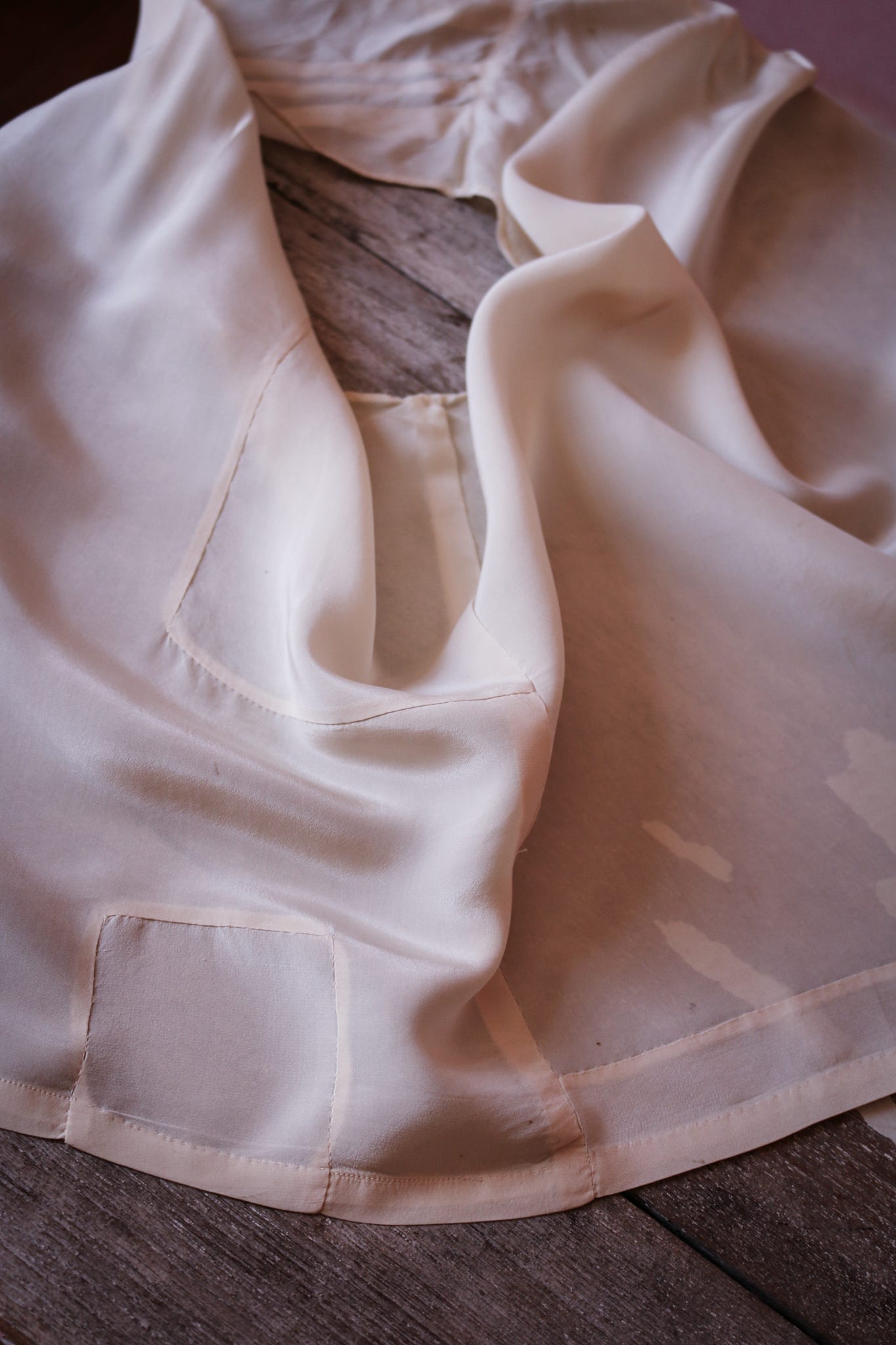
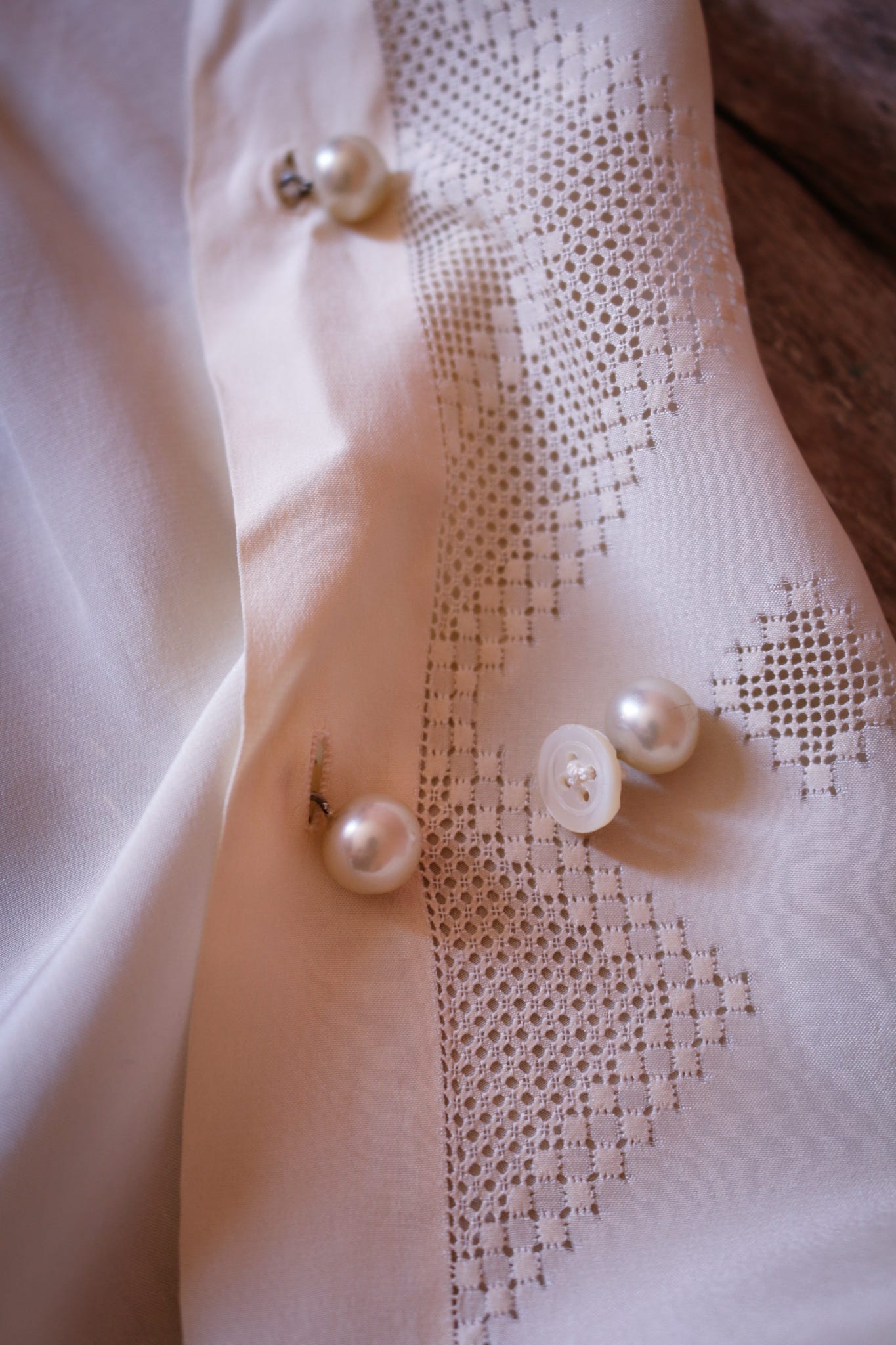




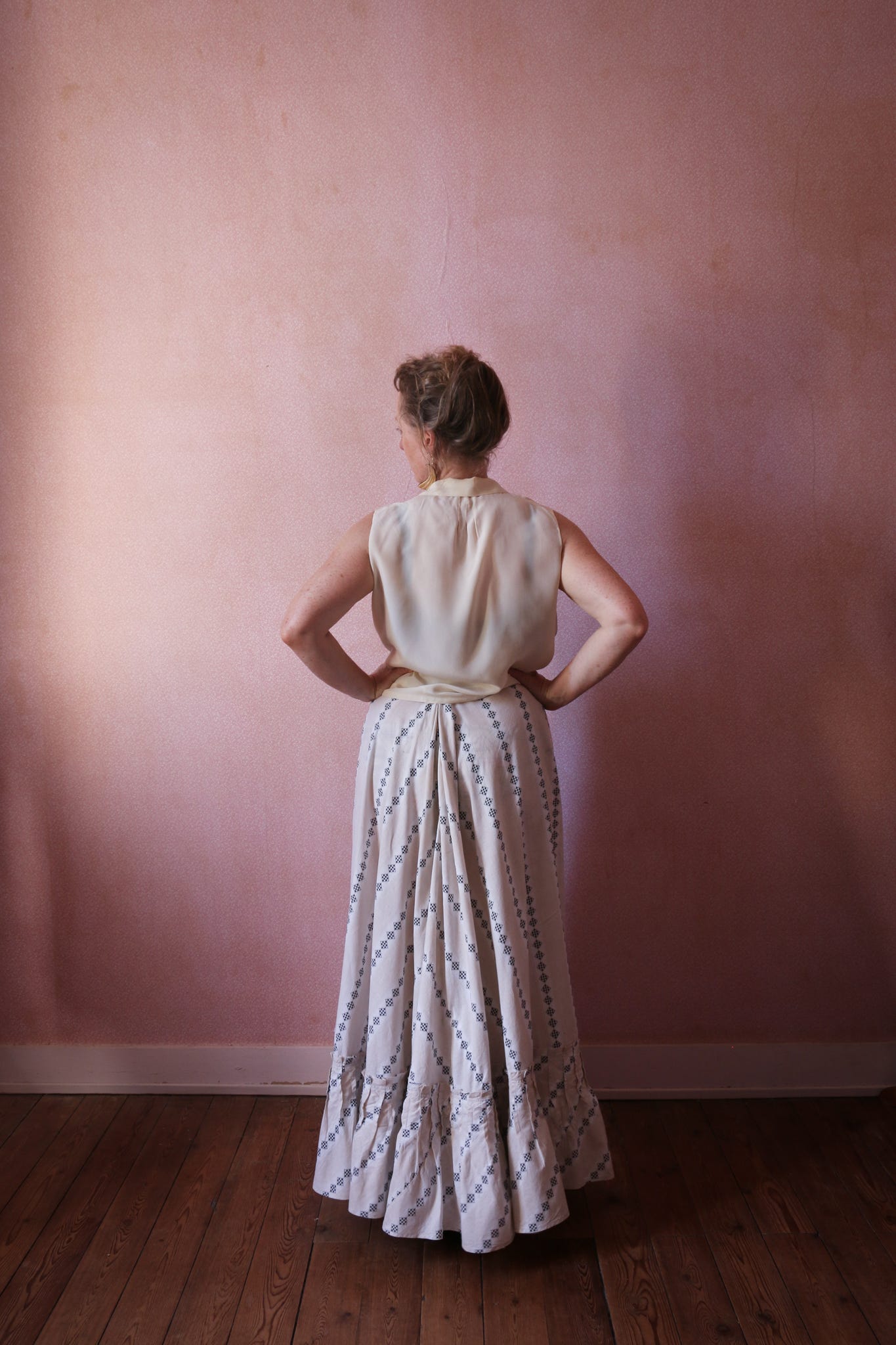
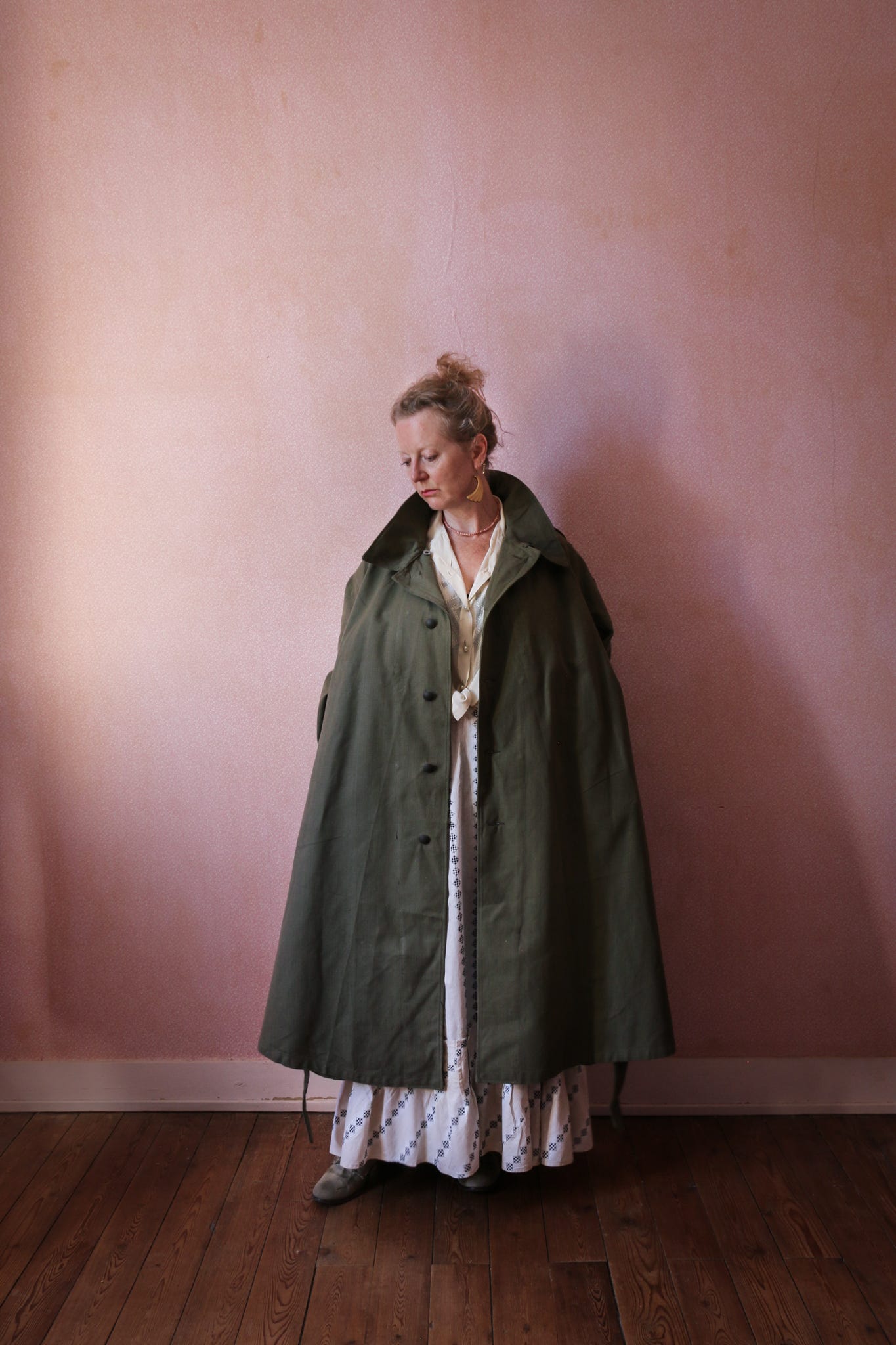


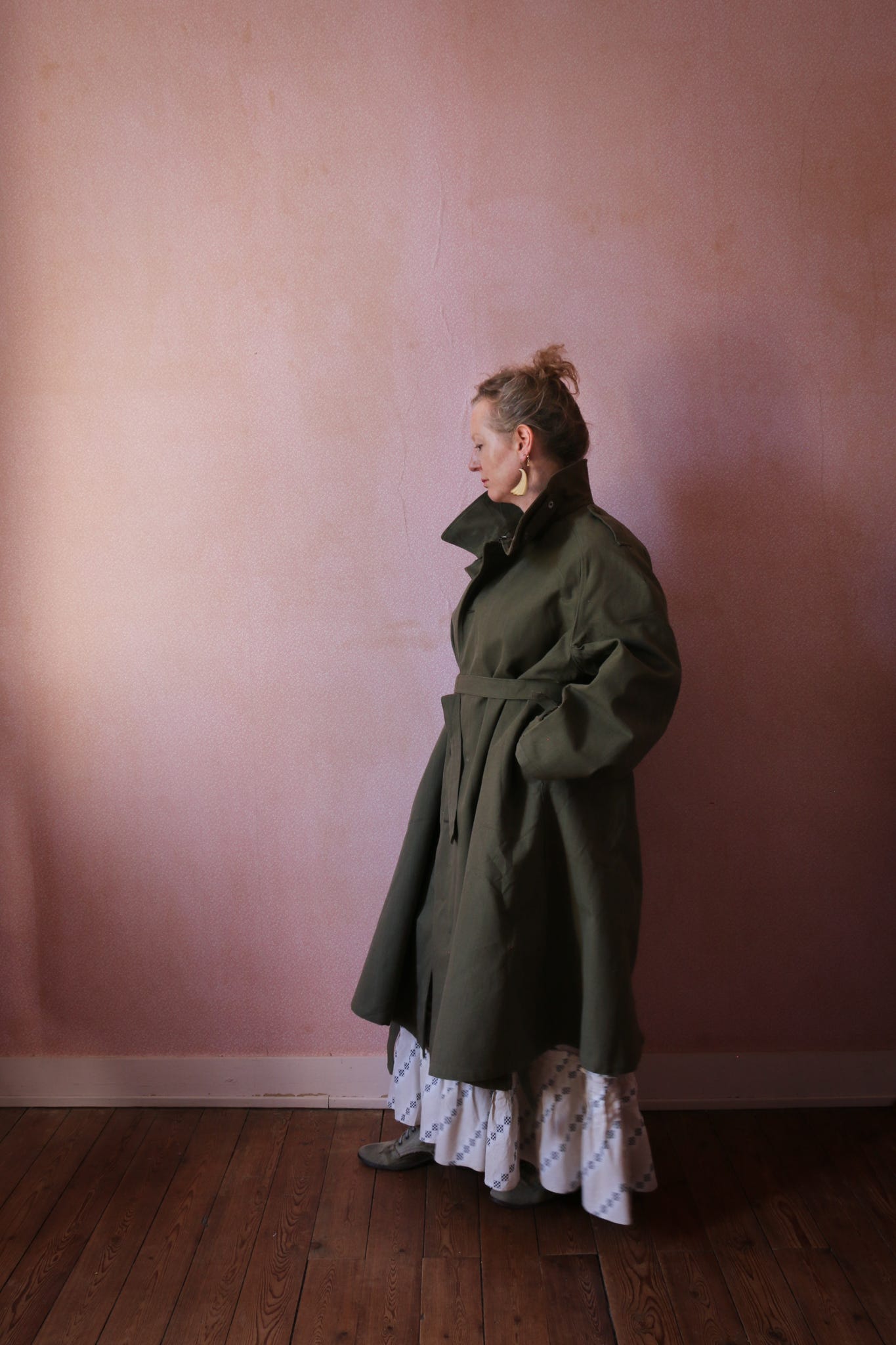
they are all beautiful garments, and you wear them very well. Thank you for sharing them.
I have never seen drawn thread work in silk! I've done it in linen, and even the little design I did took forever.
Just wanted to comment on the petticoat - somewhere in my books I have a pattern similar to that, only it's a skirt not a petticoat, and it's Edwardian. Always interesting how fashion evolves!